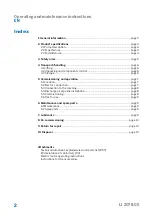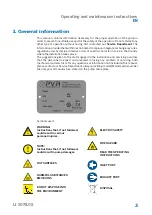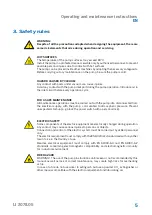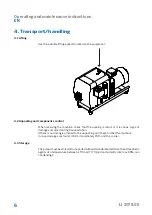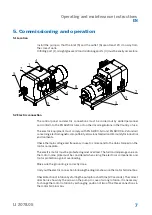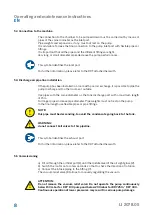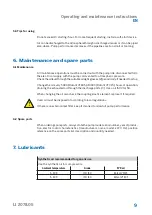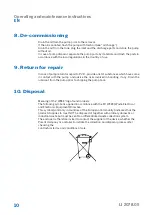
Operating and maintenance instructions
EN
8
LI 2078.05
5.3 Connection to the machine
The connection to the chamber to be pumped down must be carried out by means of
pipes of the same diameter as the inlet port.
Pipe weights and expansions, if any, must not rest on the pump.
It is advisable to make the final connection to the pump inlet port with flexible pipes or
fittings.
It is important that all the pipes and the different fittings are tight.
Very long or small diameter pipes decrease the pump performances.
This symbol identifies the inlet port.
For further information, please refer to the RDT attached herewith.
5.4 Discharge air pipe line installation
If the pump has been installed in a room with poor air exchange, it is possible to pipe the
pump discharge air to other rooms or outside.
Use pipes with the same diameter as the tank discharge port with a maximum length
of 15 m.
For longer pipes increase pipe diameter. Pipe weights must not rest on the pump.
In the final length use flexible pipes or pipe fittings.
NOTE:
this pipe must be descending, to avoid the condensate going back to the tank.
WARNING:
do not connect ball valves to this pipeline.
This symbol identifies the exhaust port.
For further information, please refer to the RDT attached herewith.
5.5 Commissioning
a) Fill oil through the oil filler port (1) until the middle level of the oil sight glass (2).
b) Switch the motor on for a few seconds so that to check the direction of rotation.
c) Connect the intake piping to the fitting (7).
The vacuum relief valve (8) allows to manually regulating the vacuum.
ATTENTION:
Do not remove the vacuum relief valve; Do not operate the pump continuously
below 150 mbar for DRY 100 pump and below 200 mbar for DRY250 / DRY 300.
Continuous operation at lower pressures may result in serious pump damage


